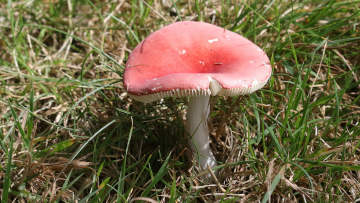Village News

PHOTO COURTESY OF GARRY KESSLER
Red russula mushroom
October 15, 2021
NATURE NOTES
By Annie Reid
Westborough Community Land Trust
Red russulas and mushroom season
It’s October, and mushrooms are springing up, seemingly overnight, on our lawns and in local woods. What a contrast to the bone-dry autumns a few years ago, when hardly a mushroom could be found! This year’s mushroom season is looking good, thanks to all the rain in summer and early fall. One eye-catching mushroom that you might spot in the woods, anytime from July through October, is the red russula.
Russulas (genus Russula) and other mushrooms are fungi. Different kinds of russulas have caps of different colors, but those with bright red caps are especially easy to spot – more so, say, than russulas with green or yellow caps. Red russulas are rather stocky mushrooms, with caps 1 to 3 inches wide, white gills, and thick, straight, white stalks up to 4 inches long. The red cap sometimes fades to pink due to rain or sunlight. Red russulas are also quite brittle. They’re among the mushrooms called brittlegills.
You might find one to several beside a woodland trail. Look for them near oaks, beeches, or pines, or in mixed woods with both pines and broad-leaf trees.
Why do red russulas appear near certain kinds of trees? One reason is that red russulas need the roots of these trees. They have a mutually beneficial relationship with tree roots, and neither the tree nor the fungus would grow as well without it. For this reason, russulas are good for forests, and so are many other mushrooms.
How does this beneficial relationship work? The mushrooms we see are the above-ground, reproductive parts of a fungus, spreading spores from their caps. The main part of the fungus, in this case a russula, exists year-round as an underground network of thin fibers. Some of these fibers surround tree roots and connect to them. The fibers add to the tree roots’ ability to take up water as well as nitrogen and phosphorus, which you might recognize as key ingredients in fertilizer. The tree in turn supplies a fraction of its sugars from photosynthesis to the russula. Both tree and fungus benefit and grow better in this relationship, known as a fungus-root (mycorrhizal) relationship.
The fungus-root relationship is a wonderful example of connectedness in the natural world, but there’s more to the red russula’s connection story. Have you noticed the all-white plants known as Indian pipes (Monotropa uniflora) in the woods, especially after a rain? Without green chlorophyll, Indian pipes can’t make their own sugars through photosynthesis. Instead, they tap into the russulas’ underground network and siphon off some of the sugars and other nutrients exchanged in the fungus-root relationship. In other words, as far as anyone knows, the Indian pipes don’t contribute anything to the relationship. They are parasites on the russulas.
Are red russulas edible? For us, no. Some other creatures do nibble them, including American red squirrels (Tamiasciurus hudsonicus), and certain slugs, snails, fruit flies, and fungus gnats. You might notice the evidence: partly eaten red russula caps, or stalks missing caps. But our digestive systems are different from a red squirrel’s. Red russulas are likely to make humans sick. There are many closely related red russulas, difficult to tell apart (even for experts). One often featured in nature guides (Russula emetica) has even been described as “the sickener” or “vomiting russula.” You can probably guess why. It causes powerfully unpleasant symptoms in people: vomiting, diarrhea, cramps, and more. Not to mention that red russulas reportedly taste bad.
Have fun spotting red russulas and mushrooms of many colors this fall – red, yellow, green, purple, orange, white, and many shades of tan or brown. The mushrooms can be as picturesque as the fall foliage. Get the kids involved in searching and counting them (but no picking!). And remember that these fungi are good for forests, not only in fungus-root relationships but also in their ecological roles as decomposers and recyclers.
Date index
Month (October)
Common name index
Scientific name index
Category index